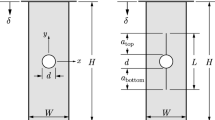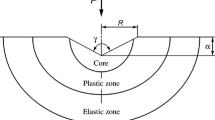Abstract
The elastic and strength properties of different grades of graphite materials as well as their fracture toughness properties are studied. The method for the determination of crack length and the values of fracture toughness characteristics of materials during stable equilibrium crack growth under bending conditions is considered. The unstable or non-equilibrium crack growth from short initial crack is observed in experiments, and corresponding theoretical explanation is given. The process of unstable crack growth is analyzed for different loading conditions. It has been shown that in the cases of short cracks, some part of stored energy transforms into kinetic energy, which can be described by the equation of energy balance during unstable crack growth.










Similar content being viewed by others
Notes
State Research Institute of Graphite-Based Structural Materials, Moscow.
Abbreviations
- α :
-
Cross-head speed
- β :
-
Rate of load decrease
- β 1 :
-
Non-dimensional rate of load decrease
- B :
-
Specimen thickness
- A i :
-
Coefficients of the polynomial Y(ω)
- b :
-
Height of the specimen
- C :
-
Compliance of notched specimen
- C 0 :
-
Initial compliance of notched specimen
- E :
-
Young’s modulus
- F(ω):
-
Integral of ωY 2(ω)
- G :
-
Elastic strain energy release rate
- \({\text{K}}\) :
-
Kinetic energy
- \({\bar{\text{K}}}\) :
-
Non-dimensional kinetic energy
- K I :
-
Stress intensity factor
- \(K_{{I_{C} }}\) :
-
Critical stress intensity factor
- a :
-
Crack length
- a 0 :
-
Initial crack length
- L :
-
Length of the specimen
- M :
-
Resulting moment at the central section of the specimen
- P с :
-
Critical load applied to the specimen
- \(\bar{P}_{c}\) :
-
Non-dimensional critical load
- P 0 c :
-
Critical load for initial crack length
- S :
-
Distance between supports of the specimen
- \({\text{U}}\) :
-
Elastic energy
- υ :
-
Load line displacement
- υ c :
-
Critical displacement
- \(\bar{\upsilon }_{c}\) :
-
Non-dimensional critical displacement
- Y(ω):
-
4-th order polynomial
- ν :
-
Poisson’s ratio
- Π:
-
Energy spent on new crack surface formation
- ω :
-
Relative crack length
- ω 0 :
-
Initial relative crack length
References
Nakhodchi S, Smith DJ, Flewitt PEJ (2013) The formation of fracture process zones in polygranular graphite as a precursor to fracture. J Mater Sci 48(2):720–732
Lomakin EV (1981) Difference in the moduli of composite materials. Mech Compos Mater 17(1):18–24
Nakhodchi S, Flewitt PEJ, Smith DJ (2008) Securing the safe performance of graphite reactor cores. Royal Society of Chemistry, Nottingham
Nakhodchi S, Flewitt PEJ, Smith DJ (2011) A method of measuring through-thickness internal strains and stress in graphite. Strain 47(1):37–48
Kelly BT (1981) Physics of graphite. Applied Science, London
Lomakin EV (2011) Constitutive models of mechanical behavior of media with stress state dependent material properties. Mechanics of Generalized Continua. Adv Struc Mater 7:339–350
Lomakin EV (2013) Deformation of solids of stress state dependent elastic properties under conditions of longitudinal shear. In: Gupta NK, Manzhirov AV, Velmurugan R (eds) Topical problems in theoretical and applied mechanics. Elite Publishing House Pvt. Ltd., New Delhi, pp 61–76
Altenbach H, Altenbach J, Zolochevsky A (1995) Erweiterte deformationsmodelle und versagenskriterien der werkstoffmechanik. Deutscher Verlag für Grundstoffindustrie, Leipzig
Lomakin EV, Fedulov BN (2015) Nonlinear anisotropic elasticity for laminate composites. Meccanica 50(6):1527–1535
Alexandrov S, Jeng Y, Lomakin E (2014) An exact semi-analytic solution for residual stresses and strains within a thin hollow disc of pressure-sensitive material subject to thermal loading. Meccanica 49(4):775–794
Lomakin E, Beliakova T (2004) Plane strain crack problems for elastic materials with variable properties. Int J Fract 128(1):183–193
Belyakova TA, Lomakin EV (2004) Elastoplastic deformation of a dilatant medium subjected to a plane stress state near a crack tip. Mech Solids 39(1):81–87
Freiman SW, Mecholsky JJ (1978) Effect of temperature and environment on crack propagation in graphite. J Mater Sci 13(6):1249–1260
Hodkinson PH, Nadeau JS (1975) Slow crack growth in graphite. J Mater Sci 10:846–856
Hodgkins A, Marrow TJ, Wootton MR, Moscovic R, Flewitt PEJ (2012) Fracture behavior of radiolytically oxidized reactor core graphites: a view. Energy Mater Mater Sci Eng Energy Syst 5(4):899–907
Li H, Singh G, Heo Y, Lin L, Fok A (2012) Fracture toughness of nuclear graphite NBG-18. Proc Int Conf Nucl Eng 1:393–397
Wang H, Sun L, Wang H, Shi L, Zhang Z (2012) An experimental study on fracture toughness of a fine-grained isotropic graphite. Proc Int Conf Nucl Eng 2(1):175–179
Joyce MR, Marrow TJ, Mummery P, Marsdon BJ (2008) Observation of microstructure deformation and damage in nuclear graphite. Eng Frac Mech 75(12):3633–3645
Becker TH, Marow TJ, Tait RB (2011) Damage, crack growth and fracture characteristics of nuclear grade graphite using the Double Torsion technique. J Nucl Mater 414(1):32–43
Cedolin L, Dei Poli S, Iori I (1983) Experimental determination of the fracture process zone in concrete. Cem Concr Res 13(4):557–567
Karihaloo BL (1995) Fracture mechanics and structural concrete. Longmans Scientific and Technical, Harrow
Shah SP, Choi S (1999) Nondestructive techniques for studying fracture processes in concrete. Int J Fract 98(3):351–359
Castro-Montero A, Jia Z, Shah SP (1995) Evaluation of damage in Brazilian test using holographic interferometry. ACI Mater 12(3):268–275
Hou F, Hong S (2014) Characterization of R-curve behavior of translaminar crack growth in cross-ply composite laminates using digital image correlation. Eng Frac Mech 117:51–70
Naumenko K, Altenbach H, Kutschke AA (2011) Combined model for hardening, softening and damage processes in advanced heat resistant steel at elevated temperature. Int J Damage Mech 20(4):578–597
Altenbach H, Huang C, Naumenko K (2002) Creep-damage predictions in thin-walled structures by use of isotropic and anisotropic damage models. J Strain Anal Engng Design 37(3):265–275
Bernardi P, Cerioni R, Michelini E (2013) Analysis of post-cracking stage in SFRC elements through a non-linear numerical approach. Eng Frac Mech 108:238–250
Alfredsson KS, Stigh U (2012) Stability of beam-like fracture mechanics specimens. Eng Frac Mech 89(1):98–113
Wildemann VE, Lomakin EV, Tretyakov MP (2014) Postcritical deformation of steels in plane stress state. Mech Solids 49(1):18–26
Irwin GR (1960) Fracture mechanics. Structural mechanics. Pergamon Press, Oxford, pp 557–594
Okamura H, Watanabe K, Takano T (1973) Applications of the compliance concept in fracture mechanics. In: Progress in flaw growth and fracture toughness testing. ASTM STP 536. ASTM, pp 423–438
Bazant ZP, Planas J (1997) Fracture and size effect in concrete and other quasibrittle materials. CRC Press LLC, London
Brown W (1966) Plain strain crack toughness testing of high strength metallic materials. American Society for Testing and Materials, Philadelphia
Berry J (1960) Some kinetic considerations of the Griffith criterion for fracture-I: equations of motion at constant force. J Mech Phys Solids 8(1):194–206
Berry J (1960) Some kinetic considerations of the Griffith criterion for fracture-II: equations of motion at constant deformation. J Mech Phys Solids 8(1):207–216
Gdoutos EE (2012) Crack growth instability studied by the strain energy density theory. Arch Appl Mech 82(10–11):1361–1376
Acknowledgments
This work was carried out in the Perm National Research Polytechnic University with the support of the Government of the Russian Federation (The Decree No 220 on April 9, 2010) under Contract 14.B25.310006 on June 24, 2013.
Author information
Authors and Affiliations
Corresponding author
Rights and permissions
About this article
Cite this article
Lomakin, E.V., Tretyakov, M.P. Fracture properties of graphite materials and analysis of crack growth under bending conditions. Meccanica 51, 2353–2364 (2016). https://doi.org/10.1007/s11012-016-0370-x
Received:
Accepted:
Published:
Issue Date:
DOI: https://doi.org/10.1007/s11012-016-0370-x




